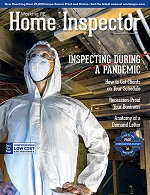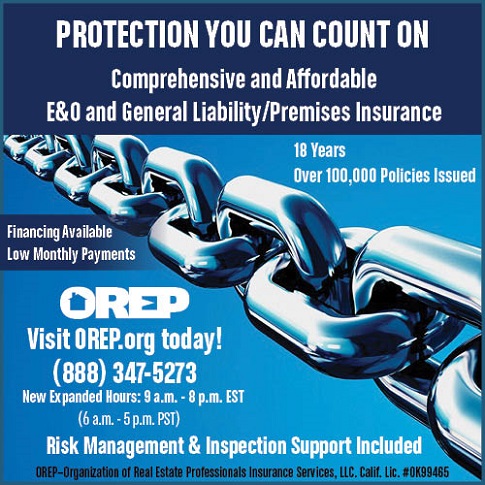 |
> E&O/GL Insurance for Home Inspectors Competitive Rates, Broad Coverage, Free Risk Management, online inspection support for tough questions, discounts on education and more... Professional Coverage, Competitive Pricing Shop OREP today! |
>> Editor’s Note: To help you stay up-to-date and connected, OREP/Working RE has established a Coronavirus (COVID-19) Discussion and Resource Page where you can share your thoughts, experiences, advice and challenges with fellow inspectors. See what Inspectors are saying here!
>> Take the Coronavirus: National Home Inspector’s Survey. Provide your industry feedback.
Using Sewer Scoping to Grow
Your Revenue
by Mark Raumikaitis, InspectorCameras.com
In today’s real estate world, successful home inspectors provide more than just a standard home inspection. Inspectors are expected to provide or arrange auxiliary services for their clients. Value added services such as testing for radon, mold and water quality bring peace of mind to the client and provide a significant source of revenue to home inspectors. Indeed, many home inspection companies bring in as much or more total revenue from auxiliary services than from the initial home inspection fee. Offering sewer scope inspections to your clients is a great way to provide additional services and added income to your home inspection business. Providing a sewer scope service also lowers liability risk for the home inspector, clients and for the real estate agent. Here are some details.
Why Sewer Inspections
Older homes used many obsolete materials for the underground sewer system. Clay pipes are susceptible to displacement, cracking and collapse. Cast-iron pipes are susceptible to displacement, corrosion, and cracking. Orangeburg, a type of resin impregnated wood fiber pipe is prone to disintegrating underground, for example. These older underground piping installations are now beyond their expected service life. These piping systems are also susceptible to root intrusion, requiring ongoing and expensive root clearing service on a regular basis. Many of these obsolete underground piping systems need significant expensive repair or replacement. Newer homes, including new construction, can also have sewer problems related to poor or faulty installation practices, damage caused by construction vehicles, construction debris inside the drains and sometimes intentional vandalism. It is recommended that even new homes have a sewer scope inspection.
Liability
Having a sewer scope performed as part of a home inspection protects everyone involved in the real estate transaction. Underground sewer and drain systems are not visible or readily accessible and are certainly beyond the scope of a standard home inspection. However, if there is an issue with the sewer drain system after transfer of title or close of escrow, you will likely get the phone call from your client. Your company, the real estate agents and likely the seller are now in the middle of a significant dispute. Underground sewer or drain problems potentially cost thousands of dollars to repair. Finger-pointing, anger, financial risk, and poor reviews on social media potentially affect everyone involved in the transaction.
Many home inspectors now add a standard comment in the home inspection report recommending a sewer scope for every inspected home. Real estate agents are becoming more accepting of this additional recommendation. The sewer scope inspection helps protect the agent and client from the liability of unknown sewer issues. At a minimum, you might consider recommending a sewer scope to your client at every home inspection, as it lowers your liability in the event of a claim.
(story continues below)
(story continues)
Revenue
Depending on your location, the price of a sewer scope service ranges from $150–$350. If you average $200 per sewer scope inspection, every 50 sewer scopes performed by your company will generate $10,000 in additional revenue. Why not take advantage of this income opportunity by providing the sewer scope service as part of your home inspection? Inspection companies that utilize a single inspector can perform the sewer scope inspection before or after the mainhome inspection. Those companies that use a multi-inspector team approach can consider combining the sewer scope inspection with other portions of the home inspection, such as interior plumbing. Multiple inspector companies operating in a single geographic location can choose to have a dedicated sewer scope inspector traveling from inspection to inspection as needed.
The process of performing the sewer scope is straightforward. The drain system is accessed through a cleanout located in the basement, crawlspace, exterior yard or in some parts of the country, from the roof through the plumbing vent stack. A pushrod type camera system is used with the camera head attached to a flexible yet rigid cable and is manually pushed into the drainpipe system.
Cameras
The preferred camera system features should include a self-leveling camera head to always orient the camera view for easier interpretation. A self-leveling camera head is beneficial when a client is viewing the actual inspection screen or viewing a video as part of the sewer scope inspection report. Adjustable LED lighting at the camera head is recommended as well. It optimizes the view of the various internal drainpipe conditions. Another beneficial feature is a distance counter providing a reading in feet or meters, indicating how far the camera head has traveled inside the drainpipe. This feature is helpful in reporting the location of issues or defects. Additional locating information can be provided by a small radio transmitter built into the camera head—this is called a Sonde. The Sonde broadcasts a continuous 512 Hz radio signal that with an additional optional radio receiver device can pinpoint the location of the camera head underground. This information is useful when deciding where excavation is necessary.
The camera system should have the ability to record color video and take still photographs also. Video and photographs can be provided to the client as part of the inspection report as needed. The inspection company should always keep copies of any video or photographs on file for future reference after the inspection.
Adding sewer scoping to your inspection services is a great way to set your company apart from your competition. Too often inspection companies compete on price alone; a better way is to compete by offering superior service and expertise. Your clients and real estate agents are looking for companies that provide a full range of services; a sewer scope inspection is one more valuable service that protects your client while providing a significant additional source of revenue for the inspector.
About the Author
Mark Raumikaitis is a NH licensed Home Inspector and Septic System Evaluator who has been inspecting residential and commercial buildings since 2000. He has earned interNACHI CMI and ASHI ACI status and has been a speaker at ASHI Inspection World. Mark now sells Sewer Inspection Cameras perfect for Home Inspectors through his company INSPECTORCAMERAS.COM
OREP/WRE Coronavirus Discussion and Resource Page
Coronavirus: National Home Inspector Survey
Free Risk Management Online Course Claims and Complaints: How to Stay Out of Trouble
Available Now
Presenter: David Brauner, Senior Insurance Broker OREP
David Brauner, Senior Broker at OREP, shares insights and advice gained over 25+ years of providing E&O insurance for inspectors, showing you how to protect yourself and your business.. Watch Now!
Note: The Summer2020 issue of Working RE Inspector is mailing now to over 25,000 home inspectors nationwide. OREP Insureds enjoy guaranteed delivery of each print magazine and many more benefits.


